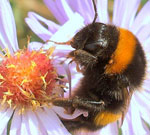WildCare farmers help save threatened bees
British farmers are helping to preserve bee colonies at a time when numbers are falling dramatically


Farmers, food processors and retailers are taking part in WildCare, a crucial wildlife habitat scheme designed to help reverse the dire threat to British bees.
The aim of the conservation programme, which is run by White Gold, a trading division of AB Agri, is to sustain natural habitats, as well as ensuring the economic viability of farming practices.
The loss of bees is now 30% per year, up from just 6% in 2003, due to a combination of poor summer weather, virus diseases and pests such as the varroa mite.
The National Audit Office’s report The health of livestock and honey bees in England (published March 3) notes that the lack of licensed medication to combat the varroa mite has resulted in beekeepers having difficulty in maintaining their colonies.
Bob Beaven, founder of the WildCare scheme, says: ‘The fall in bee numbers is very worrying, and we must do all we can to safeguard their future.
‘Our farmers carry out conservation work that provides ample food and nesting areas for bees, including sowing flower-rich habitat and only cutting hedgerows every two to three years instead of annually, which provides plentiful food sources.’
Oxfordshire dairy and arable farmer Ray Gasson, who has been part of the WildCare programme for two and a half years, says: ‘We’ve planted strips along hedge-lines with 29 different perennial wildflowers, and there’s been a massive increase in the number of bumblebees buzzing around the flowers in the summer.
Exquisite houses, the beauty of Nature, and how to get the most from your life, straight to your inbox.
‘The WildCare scheme gives a structure to the conservation work that we do—we’re following a plan, and there’s no doubt that there are more species living here than when we started.’
Cousins, head of agricultural policy for The Wildlife Trusts, who have been working with WildCare, praised the farmers involved in the scheme for helping our pressured wildlife. He says: ‘The bee’s population decline could be catastrophic for the well-being of the countryside.’
Honeybees contribute an estimated £200 million a year to Britain’s food industry, in terms of pollination for crops, and more than 30% of our diet is dependent on their activity.
To read more about the National Audit Office’s report on the future of the honeybee, see Town and Country in next week’s issue of Country Life (March 11).
To comment on this article, use the comment box below, or email us at clonews@ipcmedia.com. Read more about the countryside.
Country Life is unlike any other magazine: the only glossy weekly on the newsstand and the only magazine that has been guest-edited by His Majesty The King not once, but twice. It is a celebration of modern rural life and all its diverse joys and pleasures — that was first published in Queen Victoria's Diamond Jubilee year. Our eclectic mixture of witty and informative content — from the most up-to-date property news and commentary and a coveted glimpse inside some of the UK's best houses and gardens, to gardening, the arts and interior design, written by experts in their field — still cannot be found in print or online, anywhere else.
